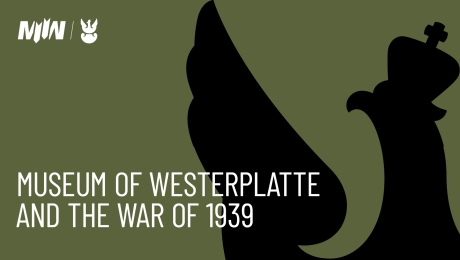POLISH ARMY SOLDIERS' CEMETERY AT WESTERPLATTE
The idea of creating a cemetery emerged along with the concept of redeveloping the peninsula. The urgent need for a new memprial arose when the fallen defenders of the Military Transit Depot were discovered and identified. The Polish Army Soldiers' Cemetery at Westerplatte is the first completed project as part of the construction of the Westerplatte and 1939 War Museum. On November 4th, 2022, a solemn burial of the heroic defenders took place there.
Cemetery History
After the surrender of the Military Transit Depot at Westerplatte in September 1939, German soldiers ordered Polish civilian prisoners of war to clear the peninsula. In addition to filling bomb craters, removing unexploded ordnance, and similar tasks, the prisoners were tasked with finding the bodies of fallen Polish soldiers and transporting them to a designated location. The Poles moved the remains of the defenders to the vicinity of guardhouse No. 5, which was destroyed during the fighting, where several graves were dug. The bodies were buried, and the burial site was marked with three mounds on which Polish military caps and crosses were placed. Later, all signs of the burials were removed, making it impossible to precisely locate the graves for many years.
Efforts to commemorate the fallen were initiated by former Captain Franciszek Dąbrowski, an officer of the Navy Cadet Corps. The first symbolic grave at Westerplatte was established shortly after the end of World War II. It was marked by a wooden cross surrounded by a low fence. It was later replaced by a concrete crucifix (popularly referred to by the main initiator's name), and a monument in the shape of the Virtuti Militari cross was erected, along with a plaque bearing the names of the fallen defenders. In subsequent years, both the space on the peninsula and the form of the symbolic cemetery underwent numerous transformations. Efforts were made to improve its surroundings and build another monument. Due to these changes, the burial space, along with access to the monument, became part of guardhouse No. 5. In 1962, the communist authorities removed the so-called Dąbrowski cross and placed a Soviet T-34 tank on the mound above the cemetery. On the 32nd anniversary of the outbreak of World War II at Westerplatte, the remains of Major Henryk Sucharski were laid to rest. Above the commander's resting place, an urn with a stylized eagle was placed. Ten years later, the Dąbrowski cross was returned to the cemetery. In the summer of 1989, mainly due to the efforts of veteran groups, the tank was relocated, and the memorial was thoroughly redesigned. The cemetery now includes 15 granite crosses with the names of the fallen defenders, and in front of them, a marble slab bearing the inscription ‘Westerplatte Defends’. In the central part, the 16th and largest crucifix was placed, symbolizing Major Sucharski, whose remains were also commemorated by a plaque indicating the burial of his remains at Westerplatte on September 1st, 1971. The Dąbrowski cross and the Virtuti Militari cross are on the right side of the cemetery. However, the latter, due to its condition, was decided to be removed, and another cross was placed in its stead, resting on the aforementioned marble slabs.
Modern Cemetery Concept
During archaeological excavations conducted by the Museum of the Second World War in 2019, researchers discovered the remains of the fallen defenders. Along with the discovery of these bodies came a deep desire and need for a dignified and proper burial for the soldiers. However, the existing cemetery did not meet the conditions for interring the fallen. Archaeologists also suspected that in the remains of guardhouse No. 5, where the installation was situated, they might come across more bodies. They thus pointed out the need to investigate the area. As a result, the decision was made to demolish the existing cemetery and create a new burial space within the peninsula.
On August 10th, 2020, the Museum of the Second World War announced an international competition for the development of the urban and architectural concept for the memorial to become the final resting place for the defenders of Westerplatte. A total of 27 entries were received. In the same year, during the deliberations of the competition panel chaired by Dr. Hab. Eng. Arch. Bolesław Stelmach, a professor at the Lodz University of Technology and the director of the National Institute of Architecture and Urban Planning, the competing projects were verified and evaluated. The winning concept was presented on December 21st, 2020. The project was authored by NM Architekci, a Warsaw-based architectural firm. In February 2021, the museum entered into a contract with the winning designer.
Construction of the Cemetery Complex
The construction of the cemetery complex, in addition to the continuation of further archaeological research, involved efforts to preserve the remnants of guardhouse No. 5 and the officer's villa. It also included the reconstruction of parts of the historical communication route from 1939. Due to ongoing excavations and preparations related to transforming the architectural concept into an executive project, construction work began in May 2022. The project was completed at the turn of September and October. During this time, approval from the Provincial Building Supervision Inspectorate for the use of the cemetery was obtained.
The complex was situated in the immediate vicinity of the discovery of the fallen soldiers' remains. Thanks to the chosen concept, it preserved the previous character of the park setting. On a circular plan, individual name-bearing steles symbolizing all 15 fallen defenders were evenly distributed. In the central part of the complex, the original Virtuti Militari Order monument is located. Overlooking the cemetery is the so-called Dąbrowski Cross. The entire complex was illuminated to emphasize the relics and symbolism of the space. Shrubs of white roses were planted where the soldiers' remains were found, and the bomb crater formed on September 2nd, 1939, at one of the corners of guardhouse No. 5, was marked with decorative grasses.
The described space will be one of the most important points on the future outdoor tour of the Westerplatte and 1939 War Museum. The cemetery is also a place where soldiers buried in other parts of the country will find their final resting place if their graves are at risk of being removed.
Funeral Ceremonies
The ceremonies began on November 3rd. On that day, initiated by the Museum of the Second World War, the memory of the fallen was honored with the concert ‘Requiem in Memory of the Fallen Defenders of Westerplatte’.
This is a historical moment and an important milestone in the implementation of historical education in our culture of remembrance. [...] Drawing on the ceremonies related to the transfer of Major Sucharski's remains in 1971, we are enlarging the group of people who have been properly buried. Therefore, today, we fulfill our duty in the place and time we are in," emphasized Grzegorz Berendt, the director of the Museum of the Second World War, during the concert.
The funeral ceremony on November 4th began with a Mass at the Church of St. Bridget in Gdańsk. Then, the ceremony moved to the cemetery grounds. The event was attended by representatives of state, municipal, and local authorities. Among those present were also the families of the fallen, clergy, activists, and members of associations, as well as Gdańsk residents and students from schools named after the defenders of Westerplatte.
On that day, with military honors, the following individuals were laid to rest:
- Commander Major Henryk Sucharski
- Platoon Sergeant Adolf Petzelt
- Corporal Bronisław Perucki
- Corporal Jan Gębura
- Senior Rifleman Władysław Okrasa (Okraszewski)
- Legionnaire Józef Kita
- Senior Legionnaire Zygmunt Zięba
- Senior Legionnaire Ignacy Zatorski
Additionally, two as-yet-unidentified soldiers.
During the ceremonies, the Minister of National Defense, Mariusz Błaszczak, addressed the audience:
They waited a long time for this burial, a long time to be properly escorted to their final resting place, but the time has come, and today we are participating in this very important ceremony. Important for our national identity, important for shaping the attitudes of today's Polish Armed Forces soldiers, important for our national community.
The President of the Republic of Poland, Andrzej Duda, also spoke:
Let us realize that for these 9 soldiers, this is perhaps their first Catholic burial, and certainly the first formal one. Because they were buried shallowly in a pit earlier, not in a grave, let's call it by name.
A brief address was also given by the Secretary of State, Chief Conservator of Monuments, Dr. Jarosław Sellin:
The discovery by archaeologists from the Museum of the Second World War in Gdańsk of the graves of the defenders of Westerplatte undoubtedly has a scientific dimension, but above all, it has a social and patriotic dimension. The heroic defense of the Polish outpost in September 1939 has become a symbol of steadfastness and courage in the fight against evil.
Dofinansowano ze środków Ministra Kultury i Dziedzictwa Narodowego
Program wieloletni pn. „Budowa Muzeum Westerplatte i Wojny 1939 – Oddziału Muzeum II Wojny Światowej w Gdańsku”











